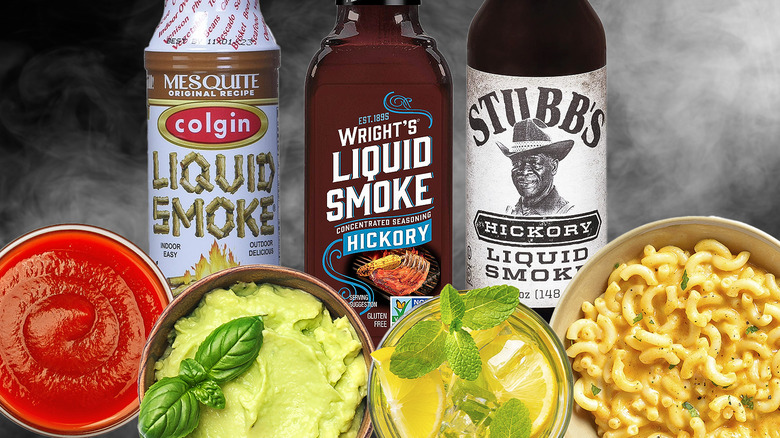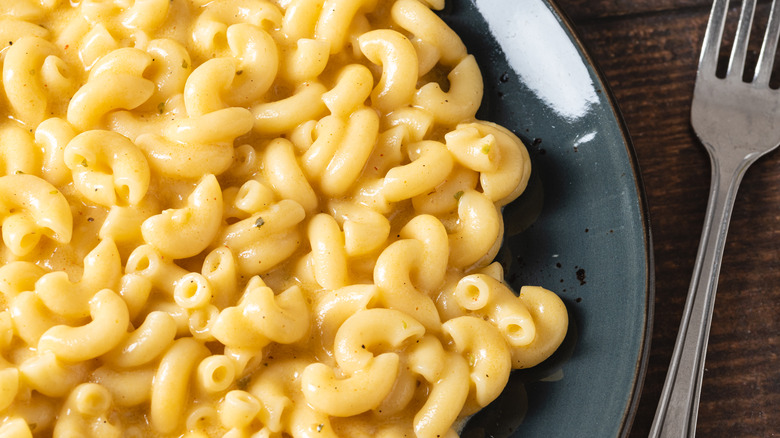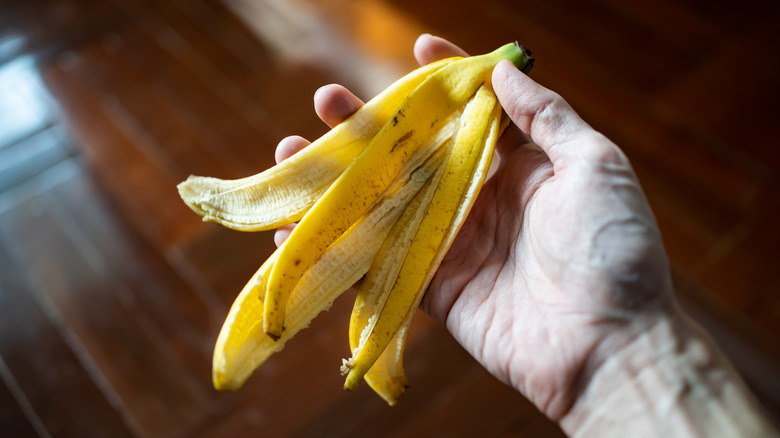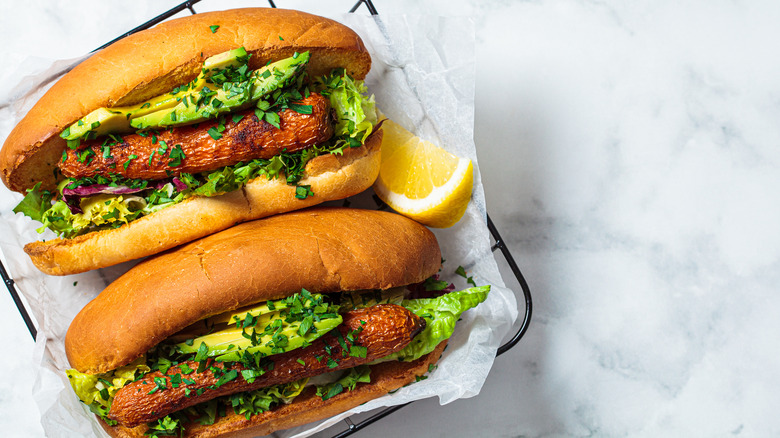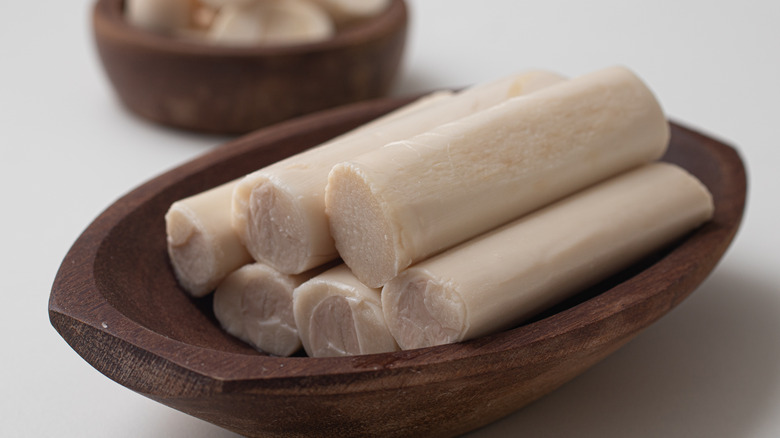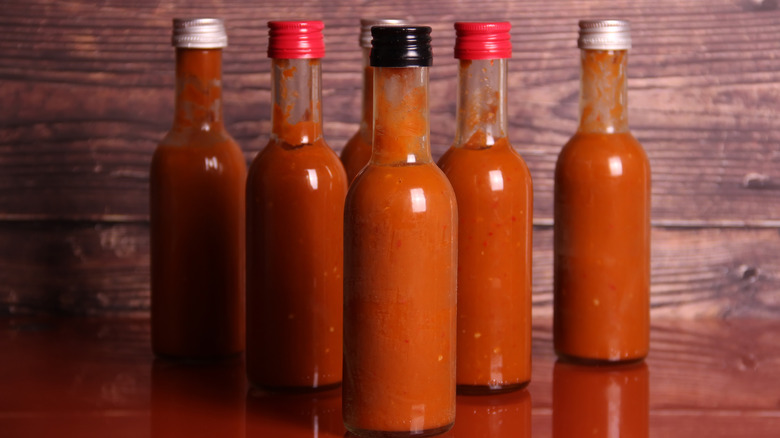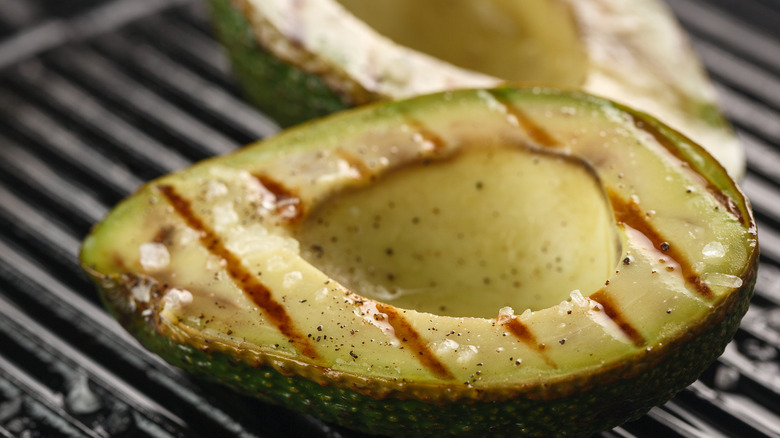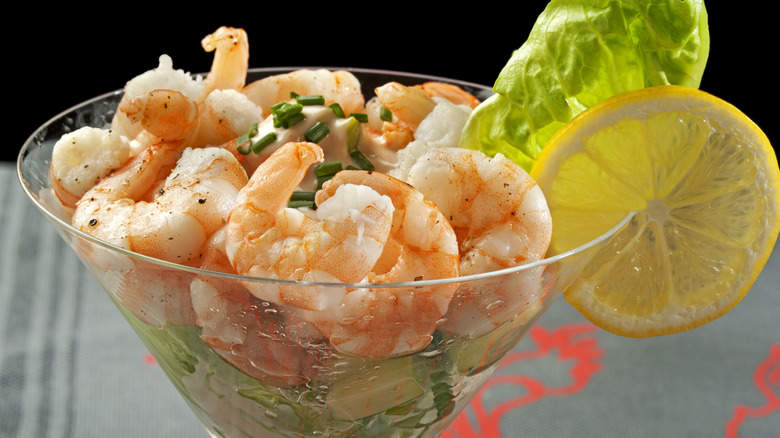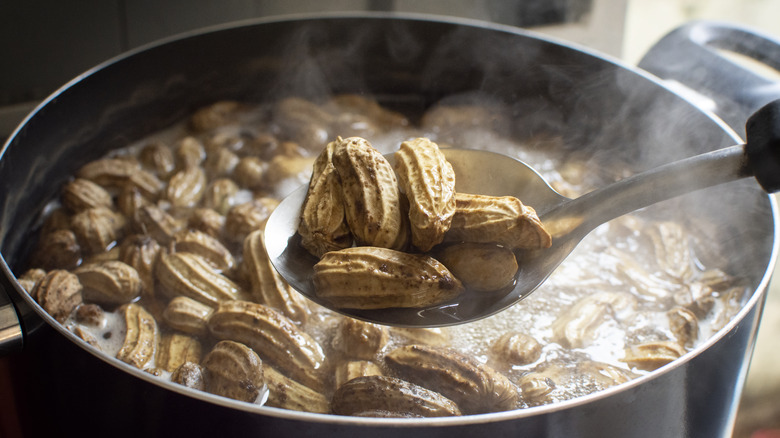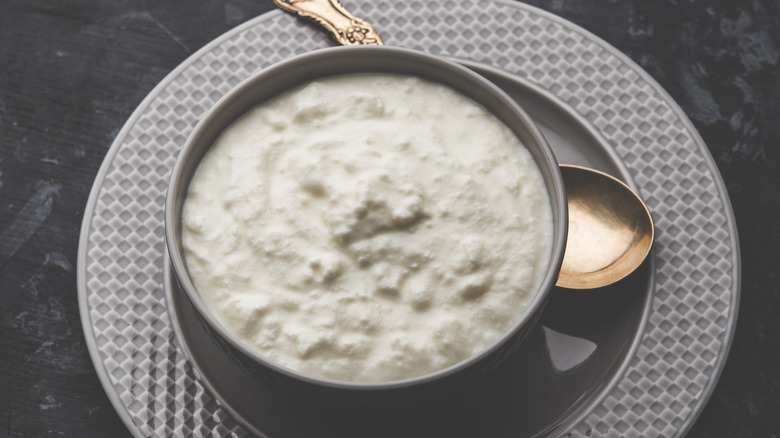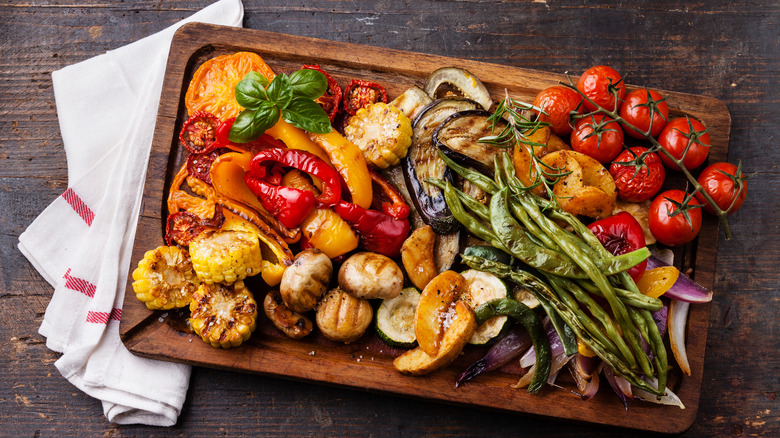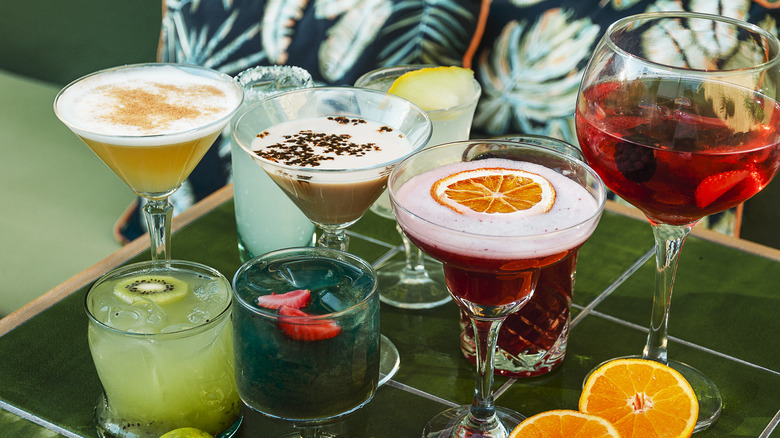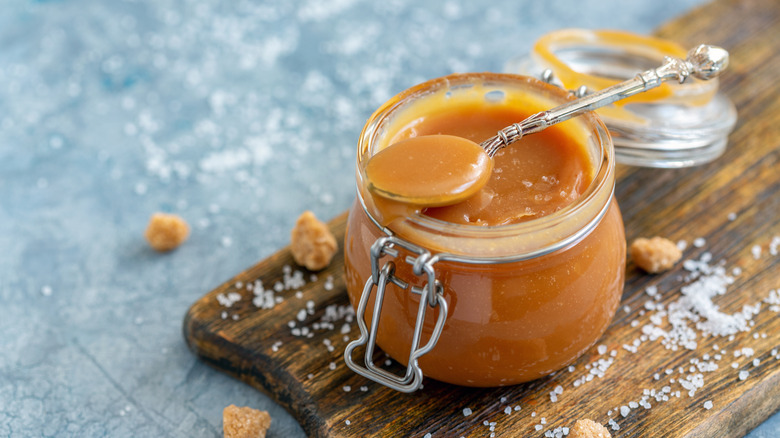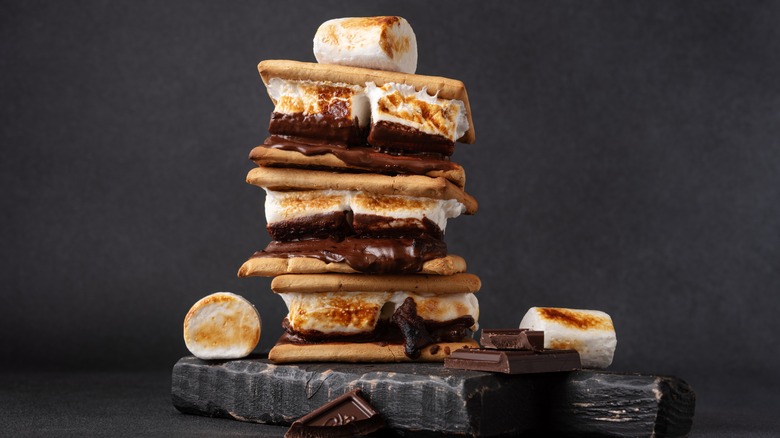13 Creative Ways To Use Liquid Smoke
The idea of putting smoke in a bottle is very poetic. It sounds like a metaphor, something akin to sand slipping through your fingers. Yet, bottling smoke is not an idiom nor a lyric from a love song; it is a well-established chemical process and has been since 1895 when American pharmacist Ernest H. Wright invented liquid smoke.
This flavoring agent is made by burning wood and capturing the smoke in a condenser, which cools it down and transforms it into liquid. This is then filtered to remove impurities and concentrated to enhance the smoky flavor. The result is an amazingly versatile and useful ingredient. Smoke flavors are tasty in many kinds of dishes, adding a distinct, robust element. There is a certain nostalgia to smokiness, too, an appealing feeling of the outdoors, of campfires, barbecues, and grilled meats.
Many of us have experimented with liquid smoke in meat dishes — it can be a quick and efficient way to whip up smoked meats or cured salmon when you don't have a smoker — or a few hours — at your disposal. But did you ever think of putting it into your desserts? Into cocktails or veggie dishes? Getting creative with liquid smoke will pay off, so here are ideas to get you started.
Make mac and cheese with a twist
Mac and cheese many people's favorite comfort food, and it is particularly fun to customize. Some of the most out-there combinations include adding Brussels sprouts, nori leaves, fish sauce, and butter chicken to this elbow pasta and cheese roux dish.
In this context, the idea of making a smoky mac and cheese seems quite reserved. After all, smoked cheeses are delicious, and can be commonly found throughout Europe and North America. The distinctive, strong flavor of smokiness complements the creamy, saltiness of cheese perfectly. If you want to give this recipe a go, cook mac and cheese in your usual way, then add liquid smoke little by little. Just a few drops can be enough to overpower your dish, so be sure to go slow, stir in each extra bit, and taste it before adding more.
The smoky flavor pairs wonderfully with a hard, sharp cheese like cheddar or gouda. You can also use a blend of cheeses, such as Parmesan, cream cheese, Gruyère, and cheddar, for an even more intense flavor profile.
Cook vegan bacon from potato skins and banana peel
While some parts of produce aren't good for humans, such as green potatoes or rhubarb leaves, many of the parts we throw away are actually highly nutritious. Banana peels are a staple in many cuisines, including Venezuelan and Indian. Both also happen to be great ingredients for making vegan bacon — provided you have some liquid smoke around to recreate that smoky, umami flavor that makes strips of salt-cured pork so tasty.
To make sweet potato skin bacon, you can simply peel your tuber with long strips, brush them with coconut aminos and liquid smoke, and pop them in the oven. You can also add other seasonings, such as herbs or maple syrup.
Banana peel bacon takes a little more time, as you need to marinate it. Take very ripe banana peels and add them to a combination of liquid smoke, Worcestershire sauce, onion powder, garlic, and your favorite barbecue seasonings. Let it marinate for 10 minutes to three hours, depending on how deep you want the flavors to be. Then, fry them in a pan over medium heat until they turn golden and crispy. These recipes take something that is usually seen as waste and turn it into an absolute treat.
Turn carrots into vegan hot dog sausages
Liquid smoke is a useful ingredient for any vegan pantry because it can transform many different plant-based proteins and vegetables into meat substitutes that really satisfy meat cravings. One standout example is turning carrots into vegan sausages, using liquid smoke to give them a true hot dog flavor. Carrot hot dogs are surprisingly easy to make and offer a healthy alternative for those seeking to increase their vegetable intake or reduce their processed meat consumption.
To begin, select medium-sized carrots that are uniform in size for even cooking. Peel the carrots and trim the ends to resemble hot dog shapes. To get the best texture, partially cook the carrots by boiling them in water for about 10 minutes until they are tender yet still firm. This step ensures the carrots retain a slight bite, similar to traditional hot dogs. Marinades vary from recipe to recipe but generally include soy sauce and liquid smoke with various spices. Soak your carrots for at least four hours; overnight marination is even better.
Once marinated, grill or pan-fry the carrots until they develop a nice char and are thoroughly heated. Grilling enhances the smoky flavor and provides a lightly crisp exterior, properly mimicking the texture of a hot dog sausage. Serve the carrots in hot dog buns, topped with your favorite condiments.
Make a vegan variant of a Jewish deli-style whitefish salad
When Ashkenazi Jewish immigrants arrived in the United States in the 19th and 20th centuries, they discovered whitefish in the Great Lakes that reminded them of the freshwater whitefish from home. Whitefish is ideal for smoking, with an oily consistency and mild flavor, so it quickly became a popular delicacy in the new world, much as it had been in the old. Today, whitefish salad remains a staple of Jewish American delis. Smoked whitefish is blended with sour cream, onions, lemons, and herbs, making a perfect spread for crusty bread, bagels, or an ideal topping for a pile of salad greens.
If you are vegan, you can still enjoy a plant-based whitefish salad thanks to the help of — you guessed it — liquid smoke. Author and chef Micah Siva recommends using shredded hearts of palm with a dash of liquid smoke as a great substitute for whitefish. Hearts of palm, which come from the trunks of some palm trees, have a flaky texture when shredded, similar to fish.
Set your hot sauce on fire
When you are preparing your own hot sauce, it can be easy to focus only on the spiciness and chili flavors, and forget the importance of more nuanced tastes to tickle your tingling tongue. Smokiness is a flavor that works particularly well with chili, so consider adding liquid smoke to your hot sauce to take it to the next level. It adds an umami element that harmonizes with the spice, adding complexity and layers to the sauce's flavor. The smoky aromas, reminiscent of open-flame cooking, are nostalgic to many of us and can improve your eating experience, without you even realizing it.
If you want to add smoke to your fire, be sure to add the flavor agent slowly. Liquid smoke is concentrated and needs to be used sparingly; otherwise, it can overpower even the spiciest sauce. Start with about 1 teaspoon for every 24 ounces of sauce and adjust to taste.
Improve store-bought guacamole
Picking the perfect avocados for homemade guacamole can be a guessing game. How do you know if that soft-squeeze avocado is deliciously ripe or browning inside? Of course, there are plenty of tips for choosing avocados, but sometimes, it's safer to opt for store-bought guacamole. It might lack the freshness and flavor intensity of homemade ones, but luckily, you can fix that with some easy additions.
Adding grilled avocado with liquid smoke is one great way to improve your shop-bought guacamole. Grilling avocados transforms their texture and flavor, giving them a slight char and a smoky depth that complements their natural creaminess. The heat from the grill caramelizes the sugars in the avocado, enhancing its sweetness while adding a delicious smoky flavor. This process also softens the flesh, making it even creamier and more unctuous. Liquid smoke enhances the smokiness from the grill, giving your guacamole an extra kick.
After grilling your avocado, chop it into chunks and mash them in. Whether you want to make it fully smooth or chunky depends on your personal preference. Afterward, add a drop or two of liquid smoke — once again, be cautious with quantities, as you only want a light smokiness. You don't want your guacamole to taste like an ashtray.
Follow Alton Brown's shrimp cocktail recipe
The origins of the shrimp (or prawn) cocktail are a little hazy. Some cite a 19th-century miner from California as the first to eat oysters in a glass with a ketchup-based sauce. Others point to the Golden Gate Hotel in Las Vegas, which was the first to sell shrimp cocktails for 50 cents in 1959. A tulip glass of cocktail sauce was surrounded by cooked prawns as a flavorful appetizer. In the '60s, it became a popular, glamorous starter at upscale restaurants and is still enjoyed today.
If you are looking to add a twist to the classic recipe, cooking show presenter Alton Brown suggests a smokey alternative. Known for his quirky humor and creative approach to food, Brown often looks to the science of flavors to make surprising but impressive combinations. His adaptation of a classic shrimp cocktail, published in his book "Good Eats 4", includes adding pulsed smoked almonds and liquid smoke to his cocktail sauce. This adds texture and flavors that recall those of a Romesco sauce: spicy, smoky, and ultra-savory. The smoke adds an aromatic haziness, complimenting the zestiness of the classic cocktail sauce, which is typically made from ketchup, horseradish, lemon, and hot sauce.
Create smoky Cajun boiled peanuts
There is a persistent myth about many Southern foods, including boiled peanuts, that they were created as cheap foods for soldiers during the Civil War. This erroneous origin story spreads some harmful ideas. It suggests that Southern food was born from deprivation and lack of choice, and erases the existence of certain foods until white people found them. In reality, Western African enslaved people introduced boiled peanuts to the South, and they have been popular since colonial times. Today, boiled peanuts are a beloved snack, and no road trip through the South is complete without stopping at a "boil p-nuts" stand.
Luckily, Cajun-boiled peanuts are also easy to make at home. Recipe developer Miriam Hahn makes hers in a crockpot, adding a dash of liquid smoke to the cooking liquid. This liquid infuses the peanuts with a smoky aroma and taste, mimicking the flavor of peanuts cooked over an open flame or in a smoker. On top of the classic Cajun flavors in her boiled peanuts, Hahn's addition of liquid smoke adds a depth of flavor that will remind you of Southern barbecue dishes.
Prepare an easy smoky yogurt dip
It's always handy to have a few quick recipes up your sleeve that you can whip up for surprise guests or yourself when your pantry supplies are running low. Yogurt is a versatile ingredient for making quick dips or condiments, and it has a pleasant texture and a neutral flavor that takes on the taste of other ingredients.
While in the U.S., yogurt is usually eaten as part of a sweet treat, many other countries enjoy it as a savory dish. You've probably heard of tzatziki, a Greek condiment made from yogurt and cucumber. Raita, a yogurt sauce, is often served in India with spicy dishes. Bulgarians drink tarator on summer days, a yogurt-based soup with cucumber, garlic, and dill.
A great two-ingredient dip can be made by simply adding liquid smoke to plain yogurt. The acidity, tanginess, and creaminess of yogurt go well with the distinct smokiness, creating a perfect condiment for fresh veggies, French fries, or as a replacement for mayo in a sandwich or salad.
Give your veggies or salads a smoky dressing
Anyone who describes vegetables and salads as "rabbit food" clearly hasn't played around and discovered how exciting produce can be. There are so many different ways to make your greens (and your reds, purples, or yellows) incredibly flavor-filled.
One way is to give them a smoky twist by using liquid smoke in your dressing. A Dijon mustard, maple syrup, and apple cider vinegar salad dressing with a touch of liquid smoke can work wonders with charred vegetables. Try this sauce on cauliflower, butternut squash, asparagus, or cabbage for a deliciously smoky and sweet flavor combination.
Additionally, you can experiment with other vegetables that pair well with smoky flavors,such as Zucchini, chili peppers, bell peppers, mushrooms, and eggplant. They can be served hot or cold as part of a salad. Mix them with lettuce, tomatoes, and cucumber, then cover them with a classic vinaigrette recipe enhanced with liquid smoke for an extra kick.
Whip up smoky cocktails
Mixology is a booming field, with bartenders and cocktail experts whipping up ever more creative cocktails. One ingredient that is being experimented with is liquid smoke. This isn't surprising, as smoky flavors have long been used in alcoholic beverages. Whiskies from the Islay region of Scotland are renowned for their smoky and peaty flavors, and Germany has made smoked beers for centuries. Both are made by drying malted barley over peat fires. Mexican mezcal has a distinctive smoky flavor, which comes from agave hearts being roasted over hot rocks before being fermented.
With liquid smoke, it is easier than ever to bring this smokiness to any cocktail you like. Bourbon pairs exceptionally well with smoky flavors, so cocktails like the Manhattan and the old fashioned are good places to start adding droplets of liquid smoke. You could also try adding dry amontillado sherry, vanilla extract, and liquid smoke to a lower-end bottle to mimic the flavors of barrel-aged bourbons. A smoky Michelada, a refreshing Mexican beer cocktail traditionally made with beer, lime juice, and tomato juice, is also a treat. The smokiness complements this savory and refreshing drink.
Easier still, you can make smoked ice cubes, which will add a subtle but continuous smoky hint to all your beverages. Simply add a few drops of liquid smoke to water before freezing it—the recommended ratio is ¼ teaspoons of liquid smoke for every cup of water you use.
Add a smoky twist to caramel desserts
Smoke in your desserts might not seem like an obvious pairing, but with salty-sweet treats like caramel, the combination creates a rich, complex flavor profile that's both intriguing and delicious. The sweetness of caramel complements the deep, savory notes of smoke, resulting in a balanced and layered taste. In the same way that a hint of salt can enhance your caramel, smoke adds an incomparable oomph.
This can work in many different types of desserts. You can add a few drops to sticky toffee puddings, caramel candies, caramel sauces, or caramel cakes. Liquid smoke is potent, so a little goes a long way, especially when making desserts, as the smokiness stands out more against sweet flavors. Add a couple of drops, then gradually add more to taste, ensuring the smoky flavor enhances rather than overpowers the caramel. Smokiness in desserts is definitely one for the more experimental baker, and the rewards are flavor combinations you've never experienced before.
Give your s'mores a campfire kick
When it's raining outside, or there are still a few months to go before your next vacation, you might find yourself craving the campfire treat that is s'mores. After all, sitting with loved ones, surrounded by nature, staring into the dancing flames, and checking that your marshmallow isn't burning is a simple, soul-warming pleasure. To bring all these campfire vibes and flavors into your home, you can make s'mores in an air fryer, using liquid smoke to replicate the aromas and taste of campfire smokiness.
Air fryers circulate hot air around at high speed, which allows marshmallows to cook evenly, with a crispy outer layer and a gooey middle. Within a few minutes of placing them in the appliance, you will have perfectly textured roasted marshmallows. Melt some chocolate, stir a drop of liquid smoke in evenly, and then assemble your s'mores. This is a great dessert to eat when you are feeling sad or nostalgic or to whip up for a sleepover or movie night.
